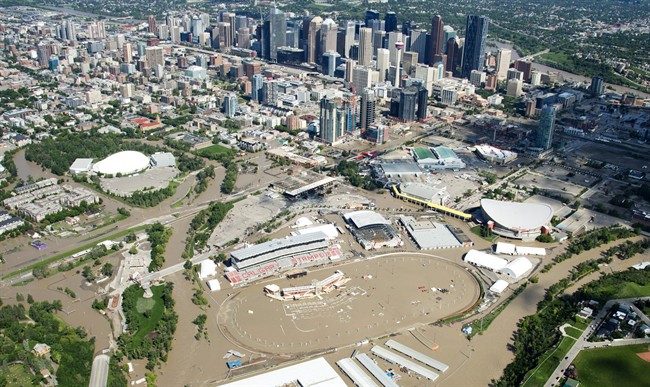It’s been a wet week for southern Alberta, a region that is still dealing with the aftermath of the devastating floods of 2013.

The wettest area has been West Castle. According to Environment Canada, from 6 p.m. June 16 to 6 a.m. June 19, the town has received a 223 mm of rain. Waterton Park follows with 195 mm. Other regions have received anywhere from 160 mm to 109 mm of rain.
READ MORE: State of Emergency continues in several southern Alberta communities
Lethbridge and Pincher Creek have each received 100 mm. To get a better idea of how much rain has fallen over just three days, on average, for the entire month of June, Lethbridge receives 82 mm of rain.
Though the flooding that many areas have endured over the past week has been costly, it’s not as bad as the flood that submerged Calgary and other parts of southern Alberta almost one year to the day.

The 2013 Alberta floods caused more than $2 billion in insured losses, making it the most expensive natural disaster in Canada’s history. Bridges were washed away, 1,000 kilometres of roads were destroyed and thousands of people suffered immense loss of property.
There were a number of factors that made the flood of 2013 so devastating. For one, the system responsible for the rain parked over the region, sitting right over the mountains for days.

Second, the precipitation that fell over the mountains fell as rain, not snow. Usually, some precipitation will fall as snow, but temperatures were so warm, it fell as rain. Combined with the thick snowpack, the heavy rain washed down through the river systems and the mountainous terrain.
The ground wasn’t thawed, so rivers swelled, flowing towards Calgary and surrounding areas. About 60 cm of the snowpack was melted during the event, making the situation even worse.
Rain totals ranged between 75 to 150 mm over two and a half days, with some areas reporting far higher amounts. Burns Creek received 345 mm, and Canmore, 200 mm.
The rain that has fallen this week has resulted in several towns declaring states of emergencies.
Dan McMurtry, a warning preparedness meteorologist with Environment Canada told Global News that there are a lot of differences between the floods of 2013 and this year.
“A major difference is that this event has happened over two and a half and three days,” McMurtry said.
“Last year many stations received between 50 to 70 per cent of the rain in the first 12 hours.”
Last year there were heavier rains over a shorter period of time and affected different watersheds. This year, rather than the Bow and Elbow rivers being affected, it’s been the Old Man watershed. This is resulting in some communities being affected that weren’t last year.
Then there’s the type of precipitation: at higher elevations, it fell as snow this year. And the snow pack didn’t melt.
Though the region can expect another 12 to 18 hours of rain, there is good news on the horizon: a drier weather pattern is developing and there will be sunshine over the next few days.




Comments